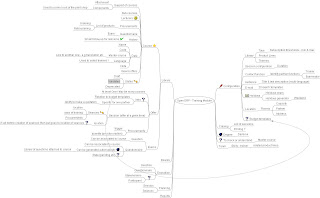Patents war is raging again.
A couple of days ago, headlines were that Microsoft patented word processing XML usage then a few days later, the news are 'Microsoft to stop shipping Word' as there are claims that they abuse a patent about document architecture and content manipulation.
For a lot of people, the patents system is viewed as a romantic ingredient. The poor, lonely, genius, self-made inventor protects it is dramatic contribution to humanity, changing our life for better... finally becomes rich and save children from the street etc etc...
Unfortunately patent is everything but this romance.
It is interesting to read these two patents, at least shortly or may be just the title.
Word-processing document stored in a single XML file that may be manipulated by applications that understand XML.
"Method and system for manipulating the architecture and the content of a document separately from each other".Both patents share the same bad patents pattern applied to software:
an attempt to present as a new invention a common practice of people in the field.
Separating content and structure is basically every day task of software developers and XML has been designed so different applications can exchange data.
How these patents claim innovation is also similar:
the combination of two existing recognized principles is supposed to be an innovation. Translated in the common world - take 'car' and 'wheel' - these are not patentable (although I heard somebody patented the wheel in Australia years ago) but spare wheel in a car could be an innovation...
The key issue with this way of seeing innovation is that it's in fact strictly prohibiting software development. Indeed most software development is about combining /assembling / adapting existing solutions (algorithms / components/ technologies) to fit a specified request.
The next meta patent could be 'solving requests by combining existing solutions'. That would patent the entire software industry... and may be the entire universe (at least business) !
In Europe, software patents do not exist (yet - there is intense lobbying on that point - they are not accepted)- although the European patent office sometimes accepts one in an attempt to extend it's business. Only software patents that have some relation with a physical device (the classical example is the ABS brakes system) are acceptable.
This European way of doing exclude most of the abuses of the American system. But...
Looking at the ABS system we can see that what is important is not the software but the logic of releasing brakes to optimize their effect. So the ABS could be patented without the mention of software at all ! Note that good car drivers knew since years that brakes blocking resulted in control loss...
So my conclusion is that the European system does does not help people protecting their software / algorithmic invention (new algorithms / new ways of digital processing / new methods of problem solving).
Business method (as we have seen for e-commerce) should not be patentable specially when they are simple translation of everyday concepts into software.
I cannot imagine a good patent system without a very strict definition of innovation. But what is innovation is a philosophical issues - I mean : subject to lengthy discussions.
May be after all the loop is closed and we should not have patents at all thus letting people, companies and the market deciding based on products qualities, usefulness and services... But that's look like jungle life - again it is not romance.


